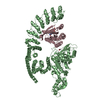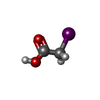+ Open data
Open data
- Basic information
Basic information
| Entry | Database: PDB / ID: 8q0n | |||||||||
|---|---|---|---|---|---|---|---|---|---|---|
| Title | HACE1 in complex with RAC1 Q61L | |||||||||
 Components Components |
| |||||||||
 Keywords Keywords | LIGASE / E3 / ubiquitin ligase / small GTPase / crosslink / SIA | |||||||||
| Function / homology |  Function and homology information Function and homology informationembryonic olfactory bulb interneuron precursor migration / anatomical structure arrangement / regulation of ERK5 cascade / angiotensin-activated signaling pathway involved in heart process / positive regulation of ovarian follicle development / cerebral cortex GABAergic interneuron development / regulation of respiratory burst / auditory receptor cell morphogenesis / cerebral cortex radially oriented cell migration / erythrocyte enucleation ...embryonic olfactory bulb interneuron precursor migration / anatomical structure arrangement / regulation of ERK5 cascade / angiotensin-activated signaling pathway involved in heart process / positive regulation of ovarian follicle development / cerebral cortex GABAergic interneuron development / regulation of respiratory burst / auditory receptor cell morphogenesis / cerebral cortex radially oriented cell migration / erythrocyte enucleation / regulation of neutrophil migration / negative regulation of interleukin-23 production / localization within membrane / Activated NTRK2 signals through CDK5 / interneuron migration / regulation of hydrogen peroxide metabolic process / kinocilium / regulation of cell adhesion involved in heart morphogenesis / negative regulation of receptor-mediated endocytosis / ruffle assembly / engulfment of apoptotic cell / NTRK2 activates RAC1 / Inactivation of CDC42 and RAC1 / NADPH oxidase complex / cochlea morphogenesis / regulation of neuron maturation / respiratory burst / WNT5:FZD7-mediated leishmania damping / SEMA3A-Plexin repulsion signaling by inhibiting Integrin adhesion / cortical cytoskeleton organization / positive regulation of skeletal muscle acetylcholine-gated channel clustering / hepatocyte growth factor receptor signaling pathway / GTP-dependent protein binding / midbrain dopaminergic neuron differentiation / epithelial cell morphogenesis / cell projection assembly / positive regulation of bicellular tight junction assembly / ruffle organization / regulation of lamellipodium assembly / thioesterase binding / HECT-type E3 ubiquitin transferase / regulation of stress fiber assembly / negative regulation of fibroblast migration / regulation of neuron migration / RHO GTPases activate CIT / cell-cell junction organization / motor neuron axon guidance / sphingosine-1-phosphate receptor signaling pathway / Nef and signal transduction / PCP/CE pathway / RHO GTPases activate KTN1 / Activation of RAC1 / MET activates RAP1 and RAC1 / regulation of nitric oxide biosynthetic process / DCC mediated attractive signaling / Sema4D mediated inhibition of cell attachment and migration / hyperosmotic response / Azathioprine ADME / Ephrin signaling / CD28 dependent Vav1 pathway / positive regulation of ruffle assembly / positive regulation of cell-substrate adhesion / positive regulation of neutrophil chemotaxis / Wnt signaling pathway, planar cell polarity pathway / superoxide anion generation / lamellipodium assembly / regulation of receptor signaling pathway via JAK-STAT / Golgi cisterna membrane / small GTPase-mediated signal transduction / NRAGE signals death through JNK / Activation of RAC1 downstream of NMDARs / dendrite morphogenesis / Rho GDP-dissociation inhibitor binding / regulation of cell size / synaptic transmission, GABAergic / positive regulation of Rho protein signal transduction / positive regulation of dendritic spine development / Golgi organization / establishment or maintenance of cell polarity / pericentriolar material / positive regulation of actin filament polymerization / Rac protein signal transduction / RHO GTPases activate PAKs / semaphorin-plexin signaling pathway / ficolin-1-rich granule membrane / regulation of postsynapse assembly / Sema3A PAK dependent Axon repulsion / EPH-ephrin mediated repulsion of cells / positive regulation of focal adhesion assembly / regulation of neuronal synaptic plasticity / RHO GTPases Activate NADPH Oxidases / anatomical structure morphogenesis / RHO GTPases Activate WASPs and WAVEs / regulation of synaptic vesicle endocytosis / positive regulation of insulin secretion involved in cellular response to glucose stimulus / RHO GTPases activate IQGAPs / protein K48-linked ubiquitination / phagocytic cup / PTK6 Regulates RHO GTPases, RAS GTPase and MAP kinases / GPVI-mediated activation cascade Similarity search - Function | |||||||||
| Biological species |  Homo sapiens (human) Homo sapiens (human) | |||||||||
| Method | ELECTRON MICROSCOPY / single particle reconstruction / cryo EM / Resolution: 4.2 Å | |||||||||
 Authors Authors | Wolter, M. / Duering, J. / Dienemann, C. / Lorenz, S. | |||||||||
| Funding support | European Union,  Germany, 2items Germany, 2items
| |||||||||
 Citation Citation |  Journal: Nat Struct Mol Biol / Year: 2024 Journal: Nat Struct Mol Biol / Year: 2024Title: Structural mechanisms of autoinhibition and substrate recognition by the ubiquitin ligase HACE1. Authors: Jonas Düring / Madita Wolter / Julia J Toplak / Camilo Torres / Olexandr Dybkov / Thornton J Fokkens / Katherine E Bohnsack / Henning Urlaub / Wieland Steinchen / Christian Dienemann / Sonja Lorenz /  Abstract: Ubiquitin ligases (E3s) are pivotal specificity determinants in the ubiquitin system by selecting substrates and decorating them with distinct ubiquitin signals. However, structure determination of ...Ubiquitin ligases (E3s) are pivotal specificity determinants in the ubiquitin system by selecting substrates and decorating them with distinct ubiquitin signals. However, structure determination of the underlying, specific E3-substrate complexes has proven challenging owing to their transient nature. In particular, it is incompletely understood how members of the catalytic cysteine-driven class of HECT-type ligases (HECTs) position substrate proteins for modification. Here, we report a cryogenic electron microscopy (cryo-EM) structure of the full-length human HECT HACE1, along with solution-based conformational analyses by small-angle X-ray scattering and hydrogen-deuterium exchange mass spectrometry. Structure-based functional analyses in vitro and in cells reveal that the activity of HACE1 is stringently regulated by dimerization-induced autoinhibition. The inhibition occurs at the first step of the catalytic cycle and is thus substrate-independent. We use mechanism-based chemical crosslinking to reconstitute a complex of activated, monomeric HACE1 with its major substrate, RAC1, determine its structure by cryo-EM and validate the binding mode by solution-based analyses. Our findings explain how HACE1 achieves selectivity in ubiquitinating the active, GTP-loaded state of RAC1 and establish a framework for interpreting mutational alterations of the HACE1-RAC1 interplay in disease. More broadly, this work illuminates central unexplored aspects in the architecture, conformational dynamics, regulation and specificity of full-length HECTs. | |||||||||
| History |
|
- Structure visualization
Structure visualization
| Structure viewer | Molecule:  Molmil Molmil Jmol/JSmol Jmol/JSmol |
|---|
- Downloads & links
Downloads & links
- Download
Download
| PDBx/mmCIF format |  8q0n.cif.gz 8q0n.cif.gz | 343.6 KB | Display |  PDBx/mmCIF format PDBx/mmCIF format |
|---|---|---|---|---|
| PDB format |  pdb8q0n.ent.gz pdb8q0n.ent.gz | Display |  PDB format PDB format | |
| PDBx/mmJSON format |  8q0n.json.gz 8q0n.json.gz | Tree view |  PDBx/mmJSON format PDBx/mmJSON format | |
| Others |  Other downloads Other downloads |
-Validation report
| Summary document |  8q0n_validation.pdf.gz 8q0n_validation.pdf.gz | 1.1 MB | Display |  wwPDB validaton report wwPDB validaton report |
|---|---|---|---|---|
| Full document |  8q0n_full_validation.pdf.gz 8q0n_full_validation.pdf.gz | 1.1 MB | Display | |
| Data in XML |  8q0n_validation.xml.gz 8q0n_validation.xml.gz | 43.3 KB | Display | |
| Data in CIF |  8q0n_validation.cif.gz 8q0n_validation.cif.gz | 62.4 KB | Display | |
| Arichive directory |  https://data.pdbj.org/pub/pdb/validation_reports/q0/8q0n https://data.pdbj.org/pub/pdb/validation_reports/q0/8q0n ftp://data.pdbj.org/pub/pdb/validation_reports/q0/8q0n ftp://data.pdbj.org/pub/pdb/validation_reports/q0/8q0n | HTTPS FTP |
-Related structure data
| Related structure data |  18056MC  8pwlC C: citing same article ( M: map data used to model this data |
|---|---|
| Similar structure data | Similarity search - Function & homology  F&H Search F&H Search |
- Links
Links
- Assembly
Assembly
| Deposited unit | 
|
|---|---|
| 1 |
|
- Components
Components
| #1: Protein | Mass: 99930.656 Da / Num. of mol.: 1 / Mutation: deletion 1-21 Source method: isolated from a genetically manipulated source Source: (gene. exp.)  Homo sapiens (human) / Gene: HACE1, KIAA1320 / Production host: Homo sapiens (human) / Gene: HACE1, KIAA1320 / Production host:  References: UniProt: Q8IYU2, HECT-type E3 ubiquitin transferase |
|---|---|
| #2: Protein | Mass: 23769.672 Da / Num. of mol.: 1 / Mutation: Q61L Source method: isolated from a genetically manipulated source Source: (gene. exp.)  Homo sapiens (human) / Gene: RAC1, TC25, MIG5 / Production host: Homo sapiens (human) / Gene: RAC1, TC25, MIG5 / Production host:  |
| #3: Chemical | ChemComp-04E / |
| #4: Chemical | ChemComp-GTP / |
| Has ligand of interest | Y |
| Has protein modification | Y |
-Experimental details
-Experiment
| Experiment | Method: ELECTRON MICROSCOPY |
|---|---|
| EM experiment | Aggregation state: PARTICLE / 3D reconstruction method: single particle reconstruction |
- Sample preparation
Sample preparation
| Component | Name: HACE1 in complex with RAC1 Q61L / Type: COMPLEX / Entity ID: #1-#2 / Source: RECOMBINANT | ||||||||||||||||
|---|---|---|---|---|---|---|---|---|---|---|---|---|---|---|---|---|---|
| Molecular weight | Experimental value: NO | ||||||||||||||||
| Source (natural) | Organism:  Homo sapiens (human) Homo sapiens (human) | ||||||||||||||||
| Source (recombinant) | Organism:  | ||||||||||||||||
| Buffer solution | pH: 8 | ||||||||||||||||
| Buffer component |
| ||||||||||||||||
| Specimen | Conc.: 0.6 mg/ml / Embedding applied: NO / Shadowing applied: NO / Staining applied: NO / Vitrification applied: YES | ||||||||||||||||
| Specimen support | Grid type: Quantifoil R1.2/1.3 | ||||||||||||||||
| Vitrification | Instrument: FEI VITROBOT MARK IV / Cryogen name: ETHANE / Humidity: 100 % / Chamber temperature: 277 K |
- Electron microscopy imaging
Electron microscopy imaging
| Experimental equipment |  Model: Titan Krios / Image courtesy: FEI Company |
|---|---|
| Microscopy | Model: FEI TITAN KRIOS |
| Electron gun | Electron source:  FIELD EMISSION GUN / Accelerating voltage: 300 kV / Illumination mode: FLOOD BEAM FIELD EMISSION GUN / Accelerating voltage: 300 kV / Illumination mode: FLOOD BEAM |
| Electron lens | Mode: BRIGHT FIELD / Nominal magnification: 105000 X / Nominal defocus max: 3500 nm / Nominal defocus min: 800 nm |
| Image recording | Electron dose: 60 e/Å2 / Film or detector model: GATAN K3 (6k x 4k) |
- Processing
Processing
| EM software |
| |||||||||||||||||||||||||||||||||
|---|---|---|---|---|---|---|---|---|---|---|---|---|---|---|---|---|---|---|---|---|---|---|---|---|---|---|---|---|---|---|---|---|---|---|
| CTF correction | Type: PHASE FLIPPING AND AMPLITUDE CORRECTION | |||||||||||||||||||||||||||||||||
| Symmetry | Point symmetry: C1 (asymmetric) | |||||||||||||||||||||||||||||||||
| 3D reconstruction | Resolution: 4.2 Å / Resolution method: FSC 0.143 CUT-OFF / Num. of particles: 256595 / Symmetry type: POINT | |||||||||||||||||||||||||||||||||
| Atomic model building | Protocol: RIGID BODY FIT | |||||||||||||||||||||||||||||||||
| Atomic model building | Source name: AlphaFold / Type: in silico model | |||||||||||||||||||||||||||||||||
| Refine LS restraints |
|
 Movie
Movie Controller
Controller




 PDBj
PDBj




















